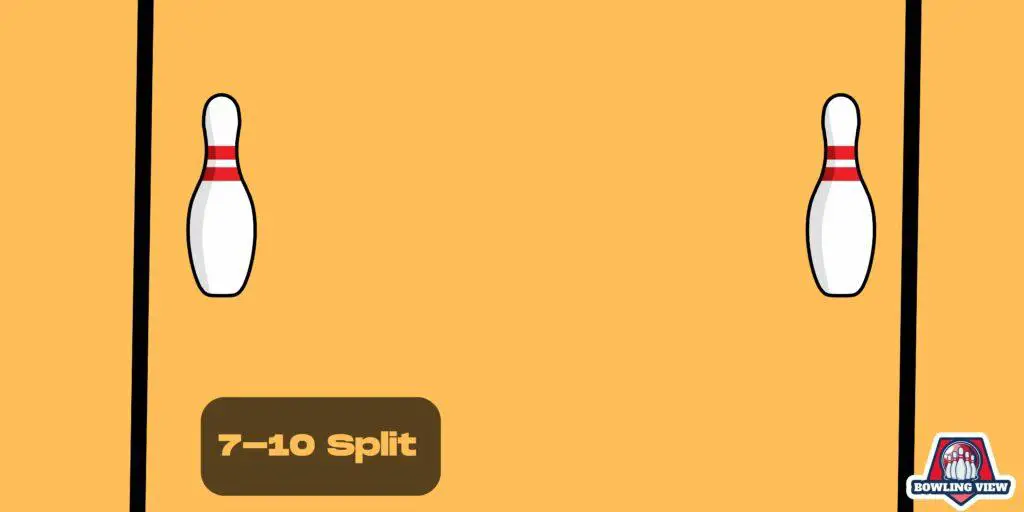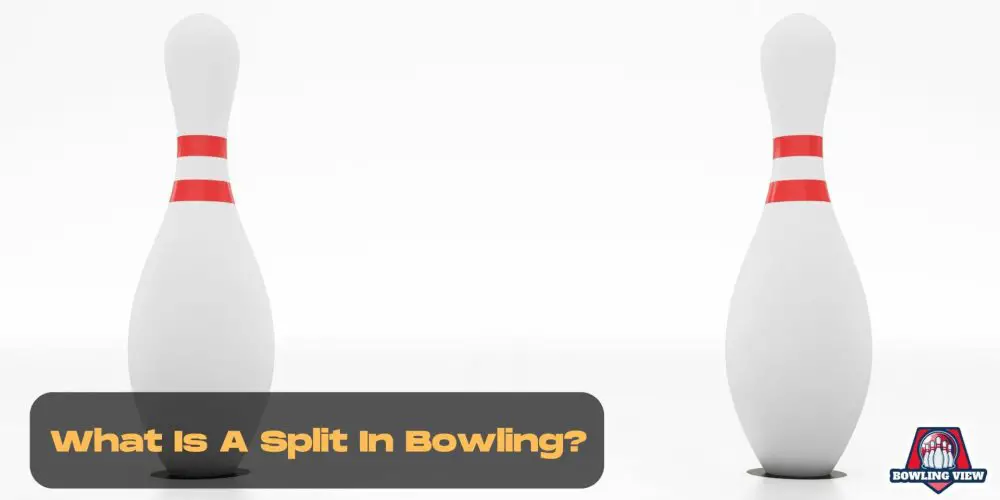Are you looking to take your bowling game to the next level? If so, learning how to pick up splits is essential. A split occurs when the bowler leaves two or more pins standing after the first ball of a frame.
It can be difficult for novice bowlers to recognize and hit splits consistently, but with practice and good technique, it can be done. In this blog post, we will discuss different types of splits, how to recognize them, and tips on how to hit them more consistently.
Plus, we’ll provide examples of successful split shots from professional bowlers and strategies for avoiding leaving splits when possible.
Finally, we’ll explain why mastering the art of splitting pins in bowling can benefit your game overall!
Definition of a split in bowling
If you are new to the world of bowling, you may have come across the term “split” and wondered what it means. A split is a term used to describe when there are two or more pins left standing on the lane with a gap between them.
This gap can be as small as an inch or as large as the entire width of the lane.
A split can be challenging to convert because there is a significant distance between the pins, making it difficult for the ball to hit both of them at once.
One example of a split is the infamous 7-10 split, where the two corner pins on the back row are left standing, and there is a gap between them equivalent to the entire width of the lane.
Converting this split is considered one of the most challenging shots in bowling and was only accomplished in a professional tournament a handful of times.
It takes skill, practice, and a bit of luck to convert these pesky splits, but with the right technique and mindset, it can be done.
Types of splits and how to recognize them
When it comes to bowling, a split can be a real headache. It happens when the ball hits the pins, but instead of knocking them all down, a few remain standing apart from one another.
There is a range of split types, each with its unique challenges that you’ll need to learn how to spot. Here are five types to look out for:
The 7-10 Split:
This one is notoriously tough to pick up because the two pins are positioned all the way on opposite corners of the lane.

The 4-6-7-9-10:
This split is also known as the Big Five and happens when the ball drives through the center of the pins, leaving a scattered cluster.
The Greek Church:
This split is also known as the “Sour Apple” and involves four pins remaining standing in a rough triangle formation.
The Baby Split:
The baby split is typically an easy pick-up, and it’s common for beginners to encounter. It occurs when just two pins are left apart from one another.
The Washout Split:
This split is formed when the headpin falls, and the remaining structure is split into three or more pins. The trouble comes with the fact that the remaining pins are spaced wide apart.
As you dive deeper into the world of bowling, recognizing these split types will become second nature. Keep in mind that while they can be frustrating, splits are also a chance to improve your skills and test your problem-solving. Happy bowling!
Tips for hitting splits more consistently
If you’re an avid bowler, you know that splits can be a real game-changer. They can either make or break your performance on the lane.
The 7-10 split, the 4-6-7-9-10, the Greek Church, the Baby Split, and the Washout – they are all challenging and require different techniques to hit the mark consistently. To improve your split game, start with the basics.
Make sure you are lining up your ball and target correctly. Use the arrows on the lanes to aim. Additionally, adjust your stance and the strength of your throw to fit each type of split. Another important factor is your equipment.
The type of ball you use can affect your shot’s velocity and trajectory, so experiment with different balls to see which works best for you. In general, hitting splits consistently comes down to practice and patience. Focus on your technique, and you’ll be able to conquer even the toughest splits.
Examples of successful split shots from professional bowlers
When it comes to bowling, nothing is more frustrating than facing a split. But there’s good news: even the pros have to deal with splits.
And sometimes, they even turn them into successful shots! For example, consider Liz Johnson’s incredible 7-10 split conversion at the 2016 Women’s U.S. Open. Or Chris Barnes’ 4-6-7-10 split spare at the 2018 PBA50 Cup.
And let’s not forget Pete Weber’s legendary 7-10 split shot during the 1991 U.S. Open finals, which he famously exclaimed, “Who do you think you are? I am!” These examples show that with skill and determination, even the toughest splits can be conquered.
So next time you find yourself staring down a tricky split, take inspiration from these pros and give it your best shot.
Strategies for avoiding leaving splits when possible
Bowling splits can be a nightmare for even the most experienced bowlers. They occur when a bowler fails to knock down all the pins in one roll, leaving at least two pins standing on opposite sides of the lane.
However, there are strategies you can take to avoid leaving splits when possible. Firstly, pay attention to the position of the pins and adjust your approach accordingly. Second, experiment with different angles of entry and release to find the most effective for your style.
Lastly, make sure you are using the proper technique and following through on your swing to increase your accuracy.
By focusing on these strategies, you can improve your bowling and minimize splits, leading to higher scores and a more enjoyable experience on the lanes.
Benefits of mastering the art of splitting pins in a bowling
If you’re a bowler, you know the disappointment of watching your ball roll straight into a cluster of pins and only knocking down a few.
This scenario describes a split in bowling, which can leave even the most seasoned bowler frustrated. However, mastering the art of splitting pins in bowling can drastically improve your game and increase your chances of achieving a high score.
Being able to successfully split the pins requires a combination of knowledge, strategy, and skill. By understanding the physics of how the pins interact with one another, recognizing different types of splits, and practicing different approaches and techniques, you can turn the daunting split into an opportunity for success.
So, the next time you encounter a split, don’t let it discourage you – embrace the challenge and work towards mastering the art of splitting pins in bowling.
Conclusion: Understanding What a Split Is in Bowling
To become a better bowler, it’s important to understand the physics of how pins interact with one another and recognize different types of splits.
With practice and proper technique, you can learn to hit these challenging shots more consistently. By mastering the art of splitting pins in bowling, you will be able to increase your chances for success on the lanes and achieve higher scores.
So don’t let those pesky clusters of pins intimidate you – use them as an opportunity to hone your skills and improve your game!
FAQs
Understanding how to pick up splits in bowling can be a difficult task. Here are some frequently asked questions about splitting pins in bowling to help you get started.
A: The hardest splits in bowling are the ones that require the most skill and precision to convert.
Some examples include the 7–10 split, the 4-6-7-9-10 split (also known as the Greek Church split), and the 5-7-10 split.
A: The most common splits in bowling are the ones that occur frequently during gameplay. Some of these include the 3-10 split (also known as the baby split), the 2-7 split, the 4-5 split, and the 5-10 split.
A: Picking up a split in bowling requires aiming and throwing the ball in such a way that it hits one pin and knocks it into the other pin(s) in order to knock them down. It takes practice and precision to successfully convert a split.
A: A split ball in bowling refers to a special type of bowling ball designed specifically for converting splits.
These balls often have unique core designs or coverstock compositions that allow for better pin action and more successful conversions.
A: The easiest split to convert in bowling is typically the one that requires knocking down the fewest number of pins.
For example, the 1-7 split or the 6-7 split may be considered easier because there is only one pin left standing in addition to the head pin.
A: Picking up the 7–10 split in bowling is a difficult task due to the wide gap between the pins.
One common technique is to aim for one side of the 7 pin and try to use the ball’s angle and pin action to knock it into the 10 pin. It requires precise execution and is often referred to as the “bedpost” or “goalpost” method.
A: The Greek Church split in bowling is a term used to describe a specific split configuration, namely the 4-6-7-9-10 split.
It gets its name because the arrangement of pins resembles the shape of a church or cathedral.
A: When you knock down every pin except one in a two-pin split, it is considered an open frame.
You will receive the appropriate score for the pins knocked down, but you will not receive a spare since there is still a pin standing.
A: Ball speed can certainly affect splitting in bowling. If the ball is thrown too fast, it may not have enough time to hook or curve into the pocket, potentially leaving splits such as the 7-10 or the Greek Church.
On the other hand, throwing the ball too slow can result in a lack of pin action and leave difficult splits as well.


